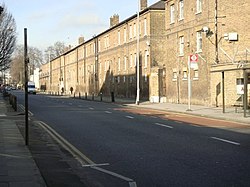The Regent's Park Barracks, commonly known as the Albany Street Barracks, is a British Army barracks located on Albany Street, London, near Regent's Park.
| Regent's Park Barracks | |
|---|---|
Albany Street Barracks | |
| London, United Kingdom | |
 Albany Street Barracks | |
| Coordinates | 51°31′57″N 0°08′41″W / 51.5325°N 0.1447°W |
| Site information | |
| Owner | Ministry of Defence |
| Operator | |
| Site history | |
| Built | 1820-1821 |
| Built for | War Office |
| Architect | John Nash |
| Garrison information | |
| Occupants | 20 Logistic Support Squadron, Royal Logistic Corps 21 Special Air Service Regiment (Artists) (Reserve) RHQ Queen's Royal Hussars |
History
editThe barracks were constructed in 1820-1821 as cavalry barracks for the Life Guards and the Royal Artillery as part of John Nash's original design for Regent's Park. Nash had originally intended the barracks to be situated in the northern area of the park, well away from the residential area, and separated from the rest of the park by Regent's Canal. However Nash's plan was not accepted in its entirety by the Crown with one of the changes involving a change in the location of the barracks to its present site.[1]
In 1848, the barracks were described in the Topographical Dictionary of England:[2]
The cavalry barracks in Albany-road are neatly built of brick, and occupy an area of eight acres and a half; the buildings comprise accommodation for 400 men, with stabling for their horses, a riding-school, infirmary, magazine, and an extensive ground for exercise.
Originally designed to house 450 officers and men and 400 horses the barracks were almost entirely rebuilt between 1891 and 1893. The rebuilding followed the original general layout, and carried out under the supervision of Colonel R. Athorpe. The layout comprises a complex of buildings arranged around a parade ground. The only building to survive from the original barracks is the officers' mess which was built between 1820 and 1821 and is situated on the east side of the parade ground. Other buildings at the northern end of the site include the Gothic chapel which was built in 1857 and the hospital which was built in 1877. Three parallel blocks used for soldiers' accommodation and stables, service buildings and the riding school were all built in 1891.[1] From 1896 to 1969, the Royal Horse Guards were based there, which later became part of the Blues and Royals.[3]
On 24 September 1971 an anarchist group called the Angry Brigade bombed the barracks in response to Operation Banner, the British Army's presence in Northern Ireland during the Troubles.[4]
Current units
editToday the barracks are the home of 20 Logistic Support Squadron, Royal Logistic Corps, 21 Special Air Service Regiment (Artists) (Reserve) and the regimental headquarters of the Queen's Royal Hussars, as well as the Queen's Royal Hussars Collection Trust charity.[5][6][7]
Popular culture
editThe music hall singer Ida Barr, whose real name was Maud Barlow, was born in the barracks on 17 January 1882, the daughter of a corporal-major in the Life Guards.[8]
In H. G. Wells' The War of the Worlds, there is a mention of the barracks: "the sound of drumming and trumpeting came from the Albany Street Barracks".[9]
References
edit- ^ a b Historic England. "Regents Park Barracks (1201740)". Research records (formerly PastScape). Retrieved 14 February 2015.
- ^ "A Topographical Dictionary of England. Originally published by S Lewis, London, 1848". British History Online. Retrieved 7 August 2020.
- ^ "Regent's Park Barracks". Museum of London. Retrieved 30 March 2014.
- ^ Carr, Gordon (1 August 2005). The Angry Brigade: a history of Britain's first urban guerilla group. Christie Books.
- ^ "London District unit locations". Ministry of Defence. Retrieved 14 February 2015.
- ^ "The Artists Rifles - From Pre-Raphaelites to Passchendaele" (PDF). Army Reserve Quarterly. Andover: Ministry of Defence. Autumn 2015. Retrieved 14 February 2015.
- ^ "The Queen's Royal Hussars Collection Trust, registered charity no. 1077734". Charity Commission for England and Wales.
- ^ Baker, Richard Anthony (2014). British Music Hall: An Illustrated History. Pen & Sword Books. p. 255. ISBN 978-1783831180.
- ^ Wells, H. G. (1898). The War of the Worlds. p. 125. ISBN 1603034013.
